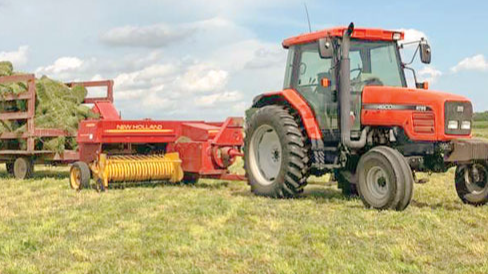“Many variables require many plans but only a few basic principles,” said Alltech representative John Winchell at an Ontario Forage Council 2020 webinar. He discussed variables involved in making high-quality forage, including digestibility, phenology, harvest timing and growing degree days.
Phenology, harvest timing and GDD
Let’s tackle phenology first; think leaves turning colors, apple blossom season and dandelion season. Phenology is the study of cyclic and seasonal natural phenomena, especially in relation to climate, plant and animal life. Winchell started tracking some of those phenology principles and their association with cool-season grasses by watching growing degree days – of dandelions.
“Old timers used to mow first-cutting grass when dandelions began to turn,” Winchell said. Dandelions begin blooming at 500 to 600 growing degree days (GDD; base 32ºF), and normal maturity cycle is nine to 15 days from bloom to seed. Old timers were “on to something,” said Winchell, as many times excellent first-cutting grass will match when dandelions are at a soft, pre-seed stage.
“Check your historical cut dates,” Winchell said, “and compare it to past years’ GDD, and you will see a pattern in your harvest analytics. Focus on the GDD and not the calendar days.”
Over 10 years, Winchell tracked the GDD at one location and found a two-week variation in optimum harvest timing based on GDD for grass/legume stands (Figures 1 and 2).
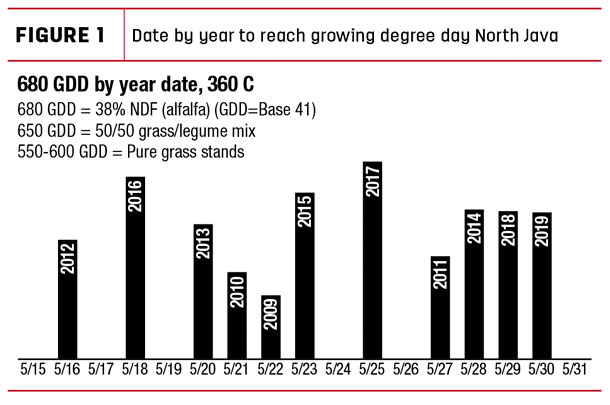
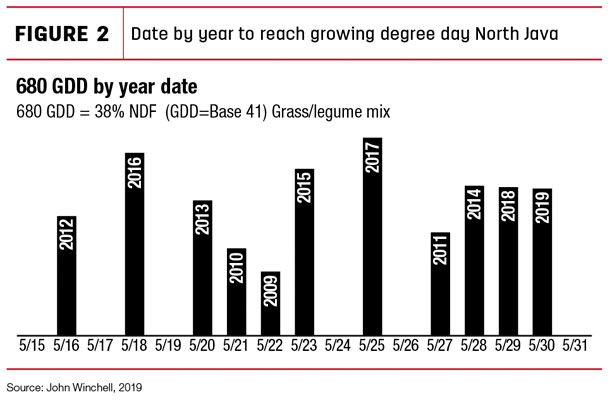
“That’s why it’s so important to hit that first cutting right,” Winchell said. “That first-cut timing sets up your schedule for the rest of the year.” He encouraged producers to find a weather app that tracks GDD with a nearby location. Winchell cautions that there’s quite a difference in small geographical areas, so it’s especially important to get a location as close as possible to the farm.
Digestibility
Crop maturity absolutely affects digestibility, as all cattle producers well know, “… so don’t miss the window,” Winchell said. “Producers need to get more familiar with the sweet spot for NDF and the digestibility numbers inside the numbers, such as ndfd30, uNDF240” on forage tests. “NDF can increase 0.75 percent per day, but the ndfd30 digestibility window decreases at a rate of 1.5 to 3 percent per day.” The uNDF240 digestibility changes even faster, which Winchell equates to “the part of the NDF you spread in the field.”
As an example, Winchell cited work from Miner Institute that looked at six corn silage samples for comparison (Figure 3).
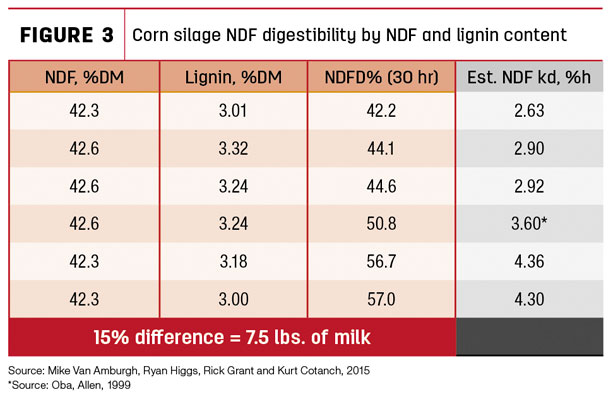
“If you look only at NDF and lignin, they don’t differ much [among the samples],” he said. “But looking at NDFD30 and NDFkd rate, which controls the rate of passage through the cow, we see high variability in how they perform – a difference of 7.5 pounds of milk, and that’s quite a difference.”
“These are newer technologies from the last 10 years that answer many questions on why seemingly the same forage can perform so much different.”
“Forage tests aren’t beauty contests,” Winchell said. “Don’t focus on pin-up forages all the time. Just consistently hit the upper range to maximize quality and quantity.” He added, “Forage quality and bunk management are the last great efficiencies in dairying. These can always be tweaked to make them even better.”
Quality forage in the field
Kile Long, a dairyman in Sterling, Illinois, isn’t entering his forage in any beauty contest, but he doesn’t have to in order to know his forage program is working; his cows are practically milking butter cubes. The butterfat from his Holstein herd is averaging 4.52%, while “the average butterfat in a Holstein dairy cow is roughly 3.8 percent,” he says, “but that could be argued depending on location.”
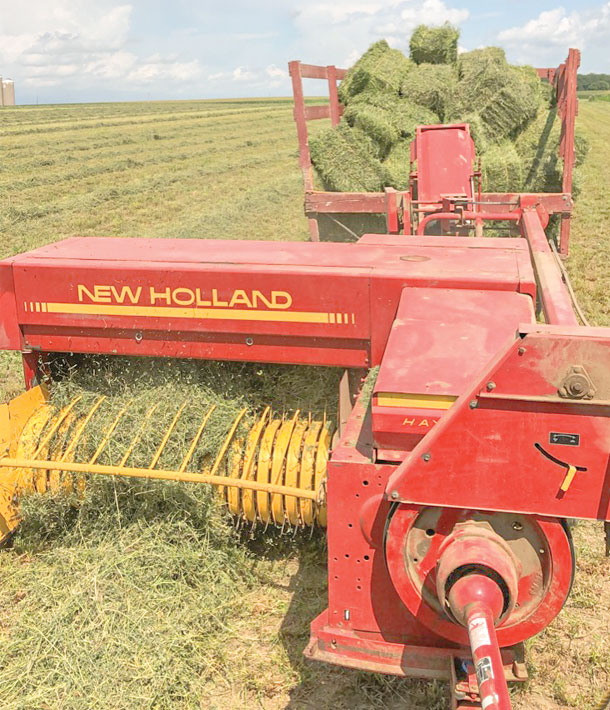
Long attributes quality forage as the reason his Holstein herd’s butterfat is averaging 4.52%. Photo by Kile Long.
Long’s herd (JuLen Registered Holsteins) production is obviously thriving. “Hay quality makes the biggest impact on butterfat,” he says. With straight alfalfa, Long takes his first cutting around Memorial Day and mows roughly every 30 days for the following three cuttings. “I try not to let the alfalfa bloom,” he says. “I can put up dry hay with three to four days of good weather, but if a storm is rolling in and it’s still wet, I can chop it and put it in the silo.” Long says he usually puts up about 7,000 small square bales a year but tries to make at least 1,000 bales each time the baler comes out of the shed.
“I can also wrap high-moisture round bales for baleage,” he says. If there’s a weather problem, he has at least a few different storage options available to make it work. His alfalfa stands last four to five years, depending on winters, then goes into corn for two years, soybeans, oats and then back into hay. “It works pretty well. We’re not having to use any anhydrous ammonia at all and just use a little manure and dry fertilizer,” he says. Insecticides, however, require applications every year after first, second and third cuttings for leafhoppers.
Long attributes much of his forage program success to the equipment he uses. “I’ve learned that a ProRotor rake has less leaf loss, and that’s where the protein value is. That’s what I attribute the higher milk quality to,” he says.
